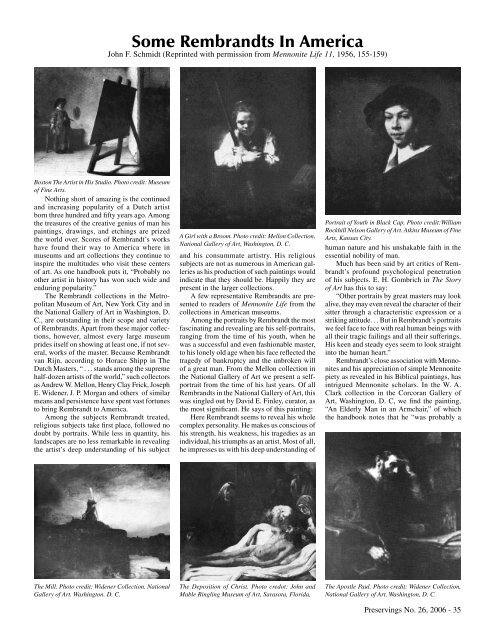Preservings $20 Issue No. 26, 2006 - Home at Plett Foundation
Preservings $20 Issue No. 26, 2006 - Home at Plett Foundation
Preservings $20 Issue No. 26, 2006 - Home at Plett Foundation
Create successful ePaper yourself
Turn your PDF publications into a flip-book with our unique Google optimized e-Paper software.
Some Rembrandts In America<br />
John F. Schmidt (Reprinted with permission from Mennonite Life 11, 1956, 155-159)<br />
Boston The Artist in His Studio. Photo credit: Museum<br />
of Fine Arts.<br />
<strong>No</strong>thing short of amazing is the continued<br />
and increasing popularity of a Dutch artist<br />
born three hundred and fifty years ago. Among<br />
the treasures of the cre<strong>at</strong>ive genius of man his<br />
paintings, drawings, and etchings are prized<br />
the world over. Scores of Rembrandt’s works<br />
have found their way to America where in<br />
museums and art collections they continue to<br />
inspire the multitudes who visit these centers<br />
of art. As one handbook puts it, “Probably no<br />
other artist in history has won such wide and<br />
enduring popularity.”<br />
The Rembrandt collections in the Metropolitan<br />
Museum of Art, New York City and in<br />
the N<strong>at</strong>ional Gallery of Art in Washington, D.<br />
C., are outstanding in their scope and variety<br />
of Rembrandts. Apart from these major coflections,<br />
however, almost every large museum<br />
prides itself on showing <strong>at</strong> least one, if not several,<br />
works of the master. Because Rembrandt<br />
van Rijn, according to Horace Shipp in The<br />
Dutch Masters, “ . . . stands among the supreme<br />
half-dozen artists of the world,” such collectors<br />
as Andrew W. Mellon, Henry Clay Frick, Joseph<br />
E. Widener, J. P. Morgan and others of similar<br />
means and persistence have spent vast fortunes<br />
to bring Rembrandt to America.<br />
Among the subjects Rembrandt tre<strong>at</strong>ed,<br />
religious subjects take first place, followed no<br />
doubt by portraits. While less in quantity, his<br />
landscapes are no less remarkable in revealing<br />
the artist’s deep understanding of his subject<br />
A Girl with a Broom. Photo credit: Mellon Collection,<br />
N<strong>at</strong>ional Gallery of Art, Washington, D. C.<br />
and his consumm<strong>at</strong>e artistry. His religious<br />
subjects are not as numerous in American galleries<br />
as his production of such paintings would<br />
indic<strong>at</strong>e th<strong>at</strong> they should be. Happily they are<br />
present in the larger collections.<br />
A few represent<strong>at</strong>ive Rembrandts are presented<br />
to readers of Mennonite Life from the<br />
collections in American museums.<br />
Among the portraits by Rembrandt the most<br />
fascin<strong>at</strong>ing and revealing are his self-portraits,<br />
ranging from the time of his youth, when he<br />
was a successful and even fashionable master,<br />
to his lonely old age when his face reflected the<br />
tragedy of bankruptcy and the unbroken will<br />
of a gre<strong>at</strong> man. From the Mellon collection in<br />
the N<strong>at</strong>ional Gallery of Art we present a selfportrait<br />
from the time of his last years. Of all<br />
Rembrandts in the N<strong>at</strong>ional Gallery of Art, this<br />
was singled out by David E. Finley, cur<strong>at</strong>or, as<br />
the most significant. He says of this painting:<br />
Here Rembrandt seems to reveal his whole<br />
complex personality. He makes us conscious of<br />
his strength, his weakness, his tragedies as an<br />
individual, his triumphs as an artist. Most of all,<br />
he impresses us with his deep understanding of<br />
Portrait of Youth in Black Cap. Photo credit:William<br />
Rockhill Nelson Gallery of Art. Atkins Museum of Fine<br />
Arts, Kansas City.<br />
human n<strong>at</strong>ure and his unshakable faith in the<br />
essential nobility of man.<br />
Much has been said by art critics of Rembrandt’s<br />
profound psychological penetr<strong>at</strong>ion<br />
of his subjects. E. H. Gombrich in The Story<br />
of Art has this to say:<br />
“Other portraits by gre<strong>at</strong> masters may look<br />
alive, they may even reveal the character of their<br />
sitter through a characteristic expression or a<br />
striking <strong>at</strong>titude. . . But in Rembrandt’s portraits<br />
we feel face to face with real human beings with<br />
all their tragic failings and all their sufferings.<br />
His keen and steady eyes seem to look straight<br />
into the human heart.”<br />
Rembrandt’s close associ<strong>at</strong>ion with Mennonites<br />
and his appreci<strong>at</strong>ion of simple Mennonite<br />
piety as revealed in his Biblical paintings, has<br />
intrigued Mennonite scholars. In the W. A.<br />
Clark collection in the Corcoran Gallery of<br />
Art, Washington, D. C, we find the painting,<br />
“An Elderly Man in an Armchair,” of which<br />
the handbook notes th<strong>at</strong> he “was probably a<br />
The Mill. Photo credit: Widener Collection. N<strong>at</strong>ional<br />
Gallery of Art. Washington. D. C.<br />
The Deposition of Christ. Photo credot: John and<br />
Mable Ringling Museum of Art, Sarasota, Florida,<br />
The Apostle Paul. Photo credit: Widener Collection,<br />
N<strong>at</strong>ional Gallery of Art, Washington, D. C.<br />
<strong>Preservings</strong> <strong>No</strong>. <strong>26</strong>, <strong>2006</strong> - 35
















